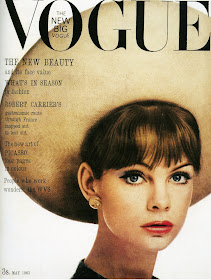If I could travel around the world to see the latest exhibitions on fashion and style, these would be my stops in May.
In Toronto at the
Bata Shoe Museum, the
Chronicles of Riches: Treasures from the Bata Shoe Museum Collection continues through to November. This exhibit showcases rarely seen items including Napolean's black silk socks worn while he lingered in exile on St. Helena and a pair of fabulous chopines from Italy dated 1580-1620. These rarely seen silk velvet covered wooden platforms are ornamented with silver lace, tassels and ruched silk.

On Wednesday, May 6th
, The Model as Muse: Embodying Fashion opens in New York at the
Metropolitan Museum of Art. This exhibition examines the evolving ideals of beauty in the world of high fashion and features iconic models of the 20th century and their roles in projecting and occasionally inspiring the fashions of their era. Haute couture and ready-to-wear fashions from 1947-1997 are displayed alongside photographs and video footage.
In London, one of my favourite museums
The Victoria and Albert Museum, continues its spring exhibition called
Baroque 1620-1800: Style in the Age of Magnificence. On display are magnificent examples of Baroque furniture, portraits, sculpture, tapestries and other object d'arts. This show examines all elements of the Baroque style which was one of the most opulent styles of the 17th and 18th Centuries.
The Costume Museum of Canada in Winnipeg has two exhibitions ongoing in May.
The Wedding Dress showcases interesting and wild wedding outfits worn through the decades and
Women of Style explores the fashion sense of 5 Winnipeg women.
In Toronto, on Wednesday, May 20th at 6:30 pm,
Alison Matthews David, Assistant Professor of Fashion History and Theory at Ryerson University, will give a talk on
Tailoring in the 18th and 19th Centuries at the
Textile Museum of Canada. Ms. Matthews David is an eloquent speaker and I'm sad that I'll have to miss this event, because the next day, I'll be leaving for Paris!

While in France, I'll be visiting the exhibition
Court Pomp & Royal Ceremonies, Court Dress in Europe 1650-1800 at
Chateau de Versailles. For more information about this unparalleled display of court garments from the 17th and 18th centuries, please see my earlier post from
April 9. I'll also be doing some other fashion and art related adventures in Paris, which may lead to some interesting articles and/or blog posts.

P.S. I've decided to import some of my book reviews of fashion related posts from
Blog of a Bookworm onto this blog. Over the past six months, I've really narrowed my focus. As my art continues to gain exposure (
today I found my work on a blog called Vintage and Chic from Spain!), two blogs is one too many!! Fashion is my passion and my muse.
P.P.S. If you missed yesterday's tag line about the winners of the Random Acts of Kindness, they are:
Kelly of the Chic Geek
Renee of Circling my Head
Lucy of Enchanted by Josephine
Judith of Studio Judith
These lovely (and lucky) bloggers will receive a gift handmade by me in the next month or two. While I hope to post most of them before my trip to Paris, that might not happen as I'm also working on a tight deadline for an art submission. But good things come to those that wait!!
 La place de l'Etoile, devenue place Charles -de-Gaulle et l'Arc de Triomphe
La place de l'Etoile, devenue place Charles -de-Gaulle et l'Arc de Triomphe





























